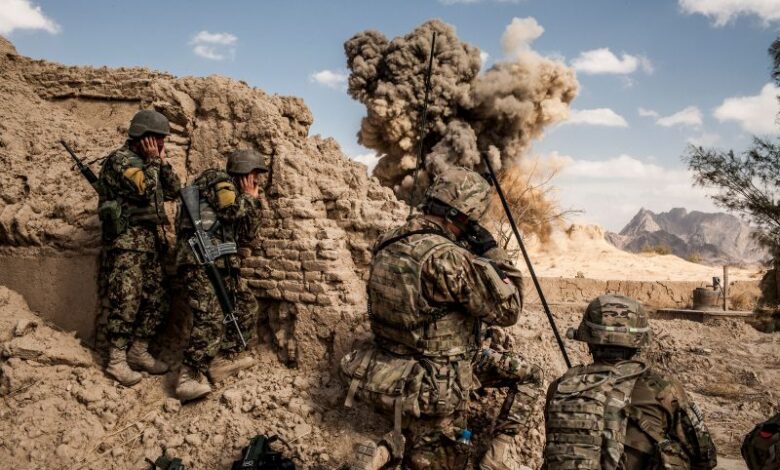
Why Is There a War in Afghanistan?
Why is there a war in Afghanistan? It’s a question that has plagued the world for decades, with roots deeply intertwined in history, politics, and social complexities. The conflict in Afghanistan is a tapestry woven with threads of foreign intervention, ethnic tensions, and economic hardship, leaving a devastating impact on the Afghan people.
To understand the current conflict, we must delve into the historical context. The Soviet invasion in the 1980s, followed by the rise of the Taliban and the subsequent US-led intervention, have all shaped the political landscape and fueled the violence.
The complex political landscape, with various factions vying for power, further complicates the situation. Economic factors, such as poverty and unemployment, contribute to the conflict, while social issues like ethnic tensions and religious extremism exacerbate the violence.
Historical Context
The ongoing conflict in Afghanistan is deeply rooted in a complex and turbulent history, shaped by internal power struggles, external interventions, and the rise of extremist ideologies. Understanding the historical context is crucial to grasping the complexities of the present situation.
The Soviet Invasion and its Aftermath
The Soviet invasion of Afghanistan in 1979 marked a turning point in the country’s history. The Soviet Union sought to install a pro-communist government in Kabul, but the invasion was met with fierce resistance from Afghan mujahideen, Islamic fighters who received support from the United States, Pakistan, and other countries.
The war lasted for ten years, resulting in significant loss of life and widespread destruction. The Soviet withdrawal in 1989 left Afghanistan in a state of chaos, with a power vacuum that allowed for the rise of the Taliban.
The Rise of the Taliban and the US-led Intervention
Following the Soviet withdrawal, Afghanistan descended into civil war. The Taliban, a fundamentalist Islamic group, emerged from the chaos and gained control of much of the country by 1996. The Taliban imposed a strict interpretation of Islamic law, banning education for girls, restricting women’s rights, and persecuting minority groups.
The Taliban’s rise to power and its brutal regime drew international condemnation, leading to the US-led invasion of Afghanistan in 2001, following the 9/11 terrorist attacks. The US and its allies accused the Taliban of harboring al-Qaeda, the terrorist group responsible for the attacks.
The war in Afghanistan is a complex issue with deep roots in history and politics. One aspect that’s often overlooked is the role of propaganda and influence operations, which can be traced back to the Cold War. The question of whether the “Office of Strategic Influence” is gone, as explored in this article is office of strategic influence gone , is relevant because it highlights how these tactics can be used to shape public opinion and influence events.
Ultimately, understanding the history of these operations is crucial to understanding the ongoing conflict in Afghanistan.
The US-led intervention initially toppled the Taliban regime, but the conflict evolved into a protracted war against a resilient insurgency. Despite significant military efforts and financial investments, the US and its allies struggled to stabilize the country and rebuild its institutions.
The Taliban gradually regained strength, exploiting instability and corruption within the Afghan government. The US withdrawal in 2021, after two decades of war, allowed the Taliban to quickly seize power, marking a dramatic shift in the Afghan landscape.
Political Factors
The war in Afghanistan is deeply rooted in the country’s complex political landscape, marked by a long history of internal conflicts, foreign interventions, and shifting power dynamics. Understanding the political factors involved is crucial to grasping the complexities of the conflict.
Political Landscape and Factions
Afghanistan’s political landscape is characterized by a multitude of factions, each with its own agenda and motivations. These factions have historically competed for power and influence, contributing to the instability that has plagued the country for decades.
- The Taliban:The Taliban emerged in the 1990s, gaining control of most of Afghanistan after the withdrawal of Soviet forces. They imposed a strict interpretation of Islamic law, banning education for girls and restricting women’s rights. Their ideology is rooted in a fundamentalist interpretation of Islam, seeking to establish an Islamic Emirate in Afghanistan.
The war in Afghanistan is a complex issue with roots deeply intertwined with the broader Middle East conflict. To truly understand the situation, it’s essential to grasp the history and complexities of the region, which you can learn more about in this insightful article on the middle east conflict a brief background.
Understanding this historical context helps shed light on the ongoing power struggles, geopolitical interests, and religious tensions that have fueled the conflict in Afghanistan for decades.
- The Afghan Government:The Afghan government, established after the US-led invasion in 2001, has been plagued by corruption, inefficiency, and a lack of legitimacy in many regions. While attempting to implement democratic reforms, it has struggled to establish a strong central authority and control the vast territory.
- Warlords and Local Militias:Warlords and local militias have played a significant role in the conflict, often operating independently of the central government and engaging in power struggles with each other and with the Taliban. These groups often control specific regions and rely on local networks for support.
- Ethnic Groups:Afghanistan is home to a diverse population, with major ethnic groups including Pashtuns, Tajiks, Hazaras, and Uzbeks. These groups have historically experienced tensions and conflicts, which have often been exploited by political actors to gain power.
Power Dynamics between the Taliban and the Afghan Government
The power dynamics between the Taliban and the Afghan government have been a defining feature of the conflict. The Taliban has maintained a strong presence in rural areas, particularly in the south and east, while the Afghan government has struggled to exert control over these regions.
The Taliban’s control over these areas has been facilitated by their strong local networks, their ability to exploit the weaknesses of the Afghan government, and their effective use of guerrilla warfare tactics.
International Actors and their Influence
The war in Afghanistan has also been shaped by the involvement of international actors, each with their own interests and objectives.
- The United States:The US intervened in Afghanistan in 2001 after the 9/11 attacks, aiming to dismantle al-Qaeda and prevent the country from becoming a safe haven for terrorists. The US-led invasion led to the overthrow of the Taliban regime, but the conflict has continued for over two decades.
The US has provided significant military and financial support to the Afghan government, but its withdrawal in 2021 led to the Taliban’s rapid takeover of the country.
- Russia:Russia has historically sought to maintain influence in Afghanistan, particularly due to its strategic location and its proximity to Central Asia. Russia has supported various factions in the conflict, including the Taliban, at different times, seeking to counter US influence in the region.
- Pakistan:Pakistan has played a complex role in the Afghan conflict, supporting both the Taliban and the Afghan government at different times. Pakistan has long-standing ties with the Taliban, and its intelligence services have been accused of providing support to the group.
However, Pakistan has also sought to maintain a stable Afghanistan, fearing that instability could spill over into its own territory.
Economic and Social Conditions: Why Is There A War In Afghanistan

The war in Afghanistan has had a devastating impact on the country’s economy and social fabric, creating a vicious cycle of poverty, unemployment, and instability. The conflict has disrupted economic activity, destroyed infrastructure, and displaced millions of people, exacerbating existing social inequalities and fueling resentment.
Economic Factors Contributing to the Conflict
The Afghan economy has been severely affected by decades of war and political instability. Poverty and unemployment are rampant, with over half the population living below the poverty line. The conflict has also led to a decline in agricultural production, a key sector of the Afghan economy, as farmers have been forced to abandon their land due to insecurity and lack of access to markets.
The war in Afghanistan is a complex conflict with roots in the Cold War and beyond. It’s easy to get caught up in the headlines and see it as a simple fight between good and evil, but the reality is much more nuanced.
One common misconception is that the war is solely about “the threat of Islam,” a misleading term that oversimplifies a complex issue. In reality, the war in Afghanistan is a multifaceted conflict fueled by a variety of factors, including political, economic, and social grievances.
The country’s reliance on foreign aid has also made it vulnerable to economic shocks, such as the withdrawal of international forces in 2021. The lack of economic opportunities, particularly for young people, has created fertile ground for recruitment by armed groups, who offer a sense of purpose and financial security.
Social Issues Fueling the Conflict, Why is there a war in afghanistan
Afghanistan is a deeply divided society, with a complex tapestry of ethnicities, tribes, and religious groups. These divisions have been exploited by various factions throughout the war, fueling ethnic tensions and tribal rivalries. The conflict has also been exacerbated by the rise of religious extremism, with groups like the Taliban exploiting religious grievances to gain support and legitimacy.
The war has also led to a breakdown in social cohesion, as communities have been fractured by displacement, violence, and fear.
Impact of the War on Afghan Civilians
The war in Afghanistan has had a devastating impact on Afghan civilians, resulting in widespread displacement, casualties, and a decline in access to essential services.
| Impact | Description | Data/Examples |
|---|---|---|
| Displacement | Millions of Afghans have been displaced from their homes due to conflict and insecurity. | According to the United Nations High Commissioner for Refugees (UNHCR), over 3.5 million Afghans were internally displaced as of 2021. |
| Casualties | The war has resulted in the deaths of thousands of civilians, including women and children. | The United Nations Assistance Mission in Afghanistan (UNAMA) documented over 10,000 civilian casualties in 2020 alone. |
| Access to Essential Services | The conflict has severely disrupted access to essential services such as healthcare, education, and sanitation. | Over 50% of Afghan children are out of school, and access to healthcare remains limited in many areas. |
Military Strategies and Tactics
The war in Afghanistan has been characterized by a complex interplay of military strategies and tactics employed by both the Taliban and the Afghan government. The conflict has evolved over time, with each side adapting its approach in response to changing circumstances and the capabilities of its adversary.
Military Strategies and Tactics of the Taliban
The Taliban’s military strategy has been primarily focused on guerrilla warfare, insurgency, and the use of improvised explosive devices (IEDs). They have leveraged their knowledge of the terrain, their ability to blend into the local population, and their use of unconventional tactics to inflict casualties on government forces and disrupt government operations.
- Guerrilla Warfare:The Taliban has effectively employed guerrilla tactics, utilizing hit-and-run attacks, ambushes, and the use of IEDs to disrupt government supply lines, attack military bases, and target government officials.
- Insurgency:The Taliban has successfully established a strong insurgency, building a network of support among the local population and utilizing their influence to recruit fighters, gather intelligence, and obtain resources.
- Improvised Explosive Devices (IEDs):IEDs have been a major weapon in the Taliban’s arsenal, causing significant casualties among government forces and civilian populations.
Military Strategies and Tactics of the Afghan Government
The Afghan government has relied on a combination of conventional warfare, counterinsurgency operations, and support from international forces to combat the Taliban. They have attempted to build a strong national army and police force capable of securing key areas and maintaining order.
- Conventional Warfare:The Afghan government has employed conventional military tactics, utilizing air power, artillery, and ground forces to engage the Taliban in open battle.
- Counterinsurgency Operations:The Afghan government has focused on counterinsurgency operations, aiming to win over the local population, disrupt the Taliban’s support network, and deny them access to resources.
- International Support:The Afghan government has heavily relied on the support of international forces, particularly the United States, for training, equipment, and air power.
Strengths and Weaknesses of Each Side
Taliban
- Strengths:
- Strong local support and knowledge of the terrain
- Effective use of guerrilla warfare and insurgency tactics
- Ability to recruit fighters and obtain resources
- Weaknesses:
- Lack of heavy weaponry and air power
- Limited access to advanced technology and logistics
- Internal divisions and factionalism
Afghan Government
- Strengths:
- Access to advanced weaponry, air power, and logistics
- Support from international forces
- Stronger conventional military capabilities
- Weaknesses:
- Limited local support and knowledge of the terrain
- Corruption and inefficiency within government institutions
- Dependence on international support
Major Military Operations and Battles
The conflict in Afghanistan has witnessed numerous major military operations and battles, each shaping the course of the war. Here is a table outlining some of the most significant engagements:
| Year | Operation/Battle | Description | Outcome |
|---|---|---|---|
| 2001 | Operation Enduring Freedom | US-led invasion of Afghanistan following the 9/11 attacks | Overthrow of the Taliban regime |
| 2006 | Operation Mountain Lion | Major offensive by US and Afghan forces in eastern Afghanistan | Significant Taliban losses but continued insurgency |
| 2010 | Operation Moshtarak | Joint operation by US, Afghan, and British forces in southern Afghanistan | Heavy fighting and Taliban casualties, but the Taliban maintained a presence |
| 2014 | Operation Freedom’s Sentinel | Transition of security responsibility to Afghan forces | Increased Taliban activity and territorial gains |
| 2021 | Fall of Kabul | Rapid collapse of the Afghan government and Taliban takeover of Kabul | Taliban victory and establishment of the Islamic Emirate of Afghanistan |
International Implications
The war in Afghanistan has had profound and far-reaching consequences, extending beyond the country’s borders and impacting the global stage. The conflict has significantly impacted neighboring countries, international security, and the global fight against terrorism.
Impact on Neighboring Countries
The conflict in Afghanistan has had a significant impact on neighboring countries, both directly and indirectly.
- Refugee Crisis:Millions of Afghans have fled their country due to the conflict, creating a massive refugee crisis in neighboring countries, particularly Pakistan and Iran. This influx of refugees has strained resources, put pressure on social services, and contributed to social and economic instability.
- Security Concerns:The conflict has spilled over into neighboring countries, with cross-border incursions, terrorist attacks, and the spread of extremist ideologies. Countries like Pakistan, Iran, and Tajikistan have faced increased security threats, leading to heightened military spending and security measures.
- Economic Impact:The conflict has disrupted trade and economic activity in the region, impacting the livelihoods of people in neighboring countries. The instability in Afghanistan has also made it difficult for foreign investors to engage in economic activities, hindering regional development.
Impact on International Security
The war in Afghanistan has had a significant impact on international security, raising concerns about the spread of terrorism, the resurgence of the Taliban, and the potential for regional instability.
- Terrorism:The conflict has provided a safe haven for terrorist groups, including al-Qaeda and ISIS, allowing them to operate, train, and plan attacks. The withdrawal of US forces has raised concerns about the resurgence of terrorist groups and their ability to launch attacks on Western countries.
- Regional Instability:The conflict has fueled regional instability, with neighboring countries becoming involved in the conflict and vying for influence. This has led to a complex web of alliances and rivalries, making it difficult to achieve lasting peace in the region.
- Global Security:The war in Afghanistan has had a significant impact on global security, as it has highlighted the challenges of fighting terrorism and maintaining stability in unstable regions. The conflict has also raised questions about the effectiveness of military interventions and the role of international organizations in conflict resolution.
Impact on Global Terrorism and Extremism
The conflict in Afghanistan has had a significant impact on global terrorism and the spread of extremism.
- Safe Haven for Terrorists:The conflict has provided a safe haven for terrorist groups, allowing them to operate, recruit, train, and plan attacks. The Taliban’s control over Afghanistan has raised concerns about the resurgence of terrorist groups and their ability to launch attacks on Western countries.
- Spread of Extremism:The conflict has fueled the spread of extremist ideologies, both within Afghanistan and beyond. The Taliban’s ideology, which is based on a strict interpretation of Islamic law, has inspired extremist groups in other countries.
- International Implications:The conflict has highlighted the challenges of combating terrorism and extremism, and the need for international cooperation to address these issues. The withdrawal of US forces has raised concerns about the potential for a resurgence of terrorism and the spread of extremism.






